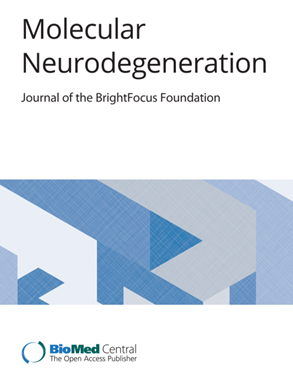阐明 CSF Aβ、tau、BACE1 和神经粒蛋白与阿尔茨海默病 AT(N)分期的关系
IF 17.5
1区 医学
Q1 NEUROSCIENCES
引用次数: 0
摘要
目前阿尔茨海默病(AD)的 AT(N)分层考虑了淀粉样蛋白(A)、tau 蛋白病(T)和神经变性(N)特征的复杂组合。了解这些不同阶段之间的转变是一项重大挑战,特别是考虑到最近疾病调整疗法的发展。这是一项观察性研究,在认知障碍患者的 BALTAZAR 队列和阿尔茨海默病神经影像学倡议(ADNI)中测量了 Tau、pTau181、pTau217、Aβ38/40/42、sAPPα/β、BACE1 和 neurogranin 的 CSF 水平。生物标志物水平与 AT(N) 框架相关。BALTAZAR中的(A)和(T)分别用CSF Aβ42/40比值和pTau217来定义,而ADNI中的(A)和(T)则用淀粉样蛋白和tau PET来定义。(N)在两个队列中均使用 CSF tau 总量定义。不出所料,随着AD从A-T-N-到A + T + N +的连续性,CSF Aβ42逐渐下降。另一方面,Tau 和 pTau181 则随着病情的发展而逐渐增加。从 A + T + N- 到 A + T + N + 的最终转变导致 Aβ38、Aβ42 和 sAPP 水平急剧上升。突触脑脊液生物标志物 BACE1 和神经粒蛋白在最初的 A + T-N- 阶段最低,并随着 T + 和 N + 而增加。两组患者的 CSF pTau181 和总 tau 密切相关。向 A + 表型(A + T-N-)的早期转变主要影响突触功能。T + 和 N + 的出现与阿尔茨海默病病理生物标志物的显著和逐渐增加有关。我们的主要发现是,CSF pTau181 是 N + 而不是 T + 的指标,N + 与 BACE1 蛋白和β-淀粉样肽水平的升高有关。这种升高可能会在正反馈循环中助长淀粉样蛋白级联。总之,我们的数据为了解阿尔茨海默病的淀粉样蛋白、tau 和神经变性等相互关联的病理过程提供了进一步的见解。本文章由计算机程序翻译,如有差异,请以英文原文为准。
Clarifying the association of CSF Aβ, tau, BACE1, and neurogranin with AT(N) stages in Alzheimer disease
Current AT(N) stratification for Alzheimer’s disease (AD) accounts for complex combinations of amyloid (A), tau proteinopathy (T) and neurodegeneration (N) signatures. Understanding the transition between these different stages is a major challenge, especially in view of the recent development of disease modifying therapy. This is an observational study, CSF levels of Tau, pTau181, pTau217, Aβ38/40/42, sAPPα/β, BACE1 and neurogranin were measured in the BALTAZAR cohort of cognitively impaired patients and in the Alzheimer's Disease Neuroimaging Initiative (ADNI). Biomarkers levels were related to the AT(N) framework. (A) and (T) were defined in BALTAZAR with CSF Aβ42/40 ratio and pTau217 respectively, and in ADNI with amyloid and tau PET. (N) was defined using total CSF tau in both cohorts. As expected, CSF Aβ42 decreased progressively with the AD continuum going from the A-T-N- to the A + T + N + profile. On the other hand, Tau and pTau181 increased progressively with the disease. The final transition from A + T + N- to A + T + N + led to a sharp increase in Aβ38, Aβ42 and sAPP levels. Synaptic CSF biomarkers BACE1 and neurogranin, were lowest in the initial A + T-N- stage and increased with T + and N + . CSF pTau181 and total tau were closely related in both cohorts. The early transition to an A + phenotype (A + T-N-) primarily impacts synaptic function. The appearance of T + and then N + is associated with a significant and progressive increase in pathological Alzheimer's disease biomarkers. Our main finding is that CSF pTau181 is an indicator of N + rather than T + , and that N + is associated with elevated levels of BACE1 protein and beta-amyloid peptides. This increase may potentially fuel the amyloid cascade in a positive feedback loop. Overall, our data provide further insights into understanding the interconnected pathological processes of amyloid, tau, and neurodegeneration underlying Alzheimer's disease.
求助全文
通过发布文献求助,成功后即可免费获取论文全文。
去求助
来源期刊

Molecular Neurodegeneration
医学-神经科学
CiteScore
23.00
自引率
4.60%
发文量
78
审稿时长
6-12 weeks
期刊介绍:
Molecular Neurodegeneration, an open-access, peer-reviewed journal, comprehensively covers neurodegeneration research at the molecular and cellular levels.
Neurodegenerative diseases, such as Alzheimer's, Parkinson's, Huntington's, and prion diseases, fall under its purview. These disorders, often linked to advanced aging and characterized by varying degrees of dementia, pose a significant public health concern with the growing aging population. Recent strides in understanding the molecular and cellular mechanisms of these neurodegenerative disorders offer valuable insights into their pathogenesis.
 求助内容:
求助内容: 应助结果提醒方式:
应助结果提醒方式:


